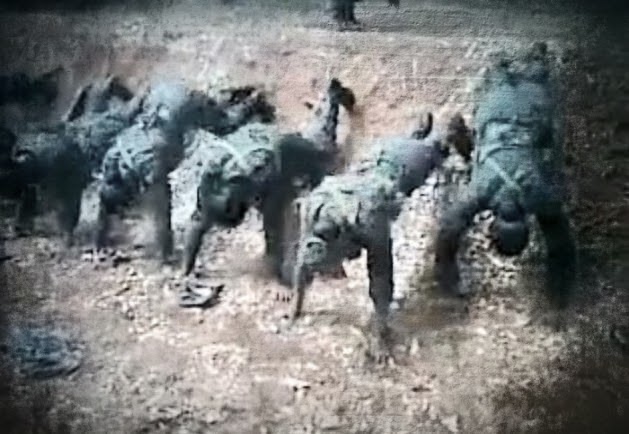 |
| Screen shot of the video |
“Evil is unspectacular and always human, And shares our bed and eats at our own table Auden (Herman Melville) For once, the military has done something sensible. It has admitted the authenticity of the footage depicting several army personnel inflicting cruel and degrading punishments on a group of female recruits .
Crimes of every sort, from rape downwards, happen in any army. But these crimes are often conducted in secret, behind at least a semi-closed door. The scenes depicted in the latest Lankan footage happen out in the open. The perpetrators seem totally at ease, almost nonchalant, with no discernible concerns about exposure, leading to censure or condemnation.
In that sense, and also because they indicate some extremely disturbing truths about a popular ‘national’ institution, these Lankan scenes are reminiscent of the footage which came from Abu Ghraib.
At Abu Ghraib, prisoner-abuse was the norm. In the footages, the uniformed torturers seem supremely at ease; they do not look as if they are concerned about being surprised in an illegal act by either peers or superiors. That very ease of manner indicated a culture of impunity which was subsequently confirmed by a high level investigation into the US army’s prison system (led by Major General Antonio Tabuga). As the legendary Seymour Hersh revealed, the resulting report’s “conclusions about the institutional failures of the Army prison system were devastating. Tabuga found that between October and December of 2003 there were numerous instances of ‘sadistic, blatant and wanton criminal abuses’ at Abu Ghraib.” The report determined that the abuses were ‘systematic’ rather than incidental.
The scenes depicted in the Lankan footage too are sadistic; only a sadist can inflict such abuse (especially on a group of weeping women) – and laugh. They are also ‘blatant and wanton’; there is no indication that the perpetrators think they are doing something ‘wrong’, a crime/misdeed which can get them into trouble. Their almost insouciant manner hints that such abusive conduct is neither unusual nor unpopular; that, as at Abu Ghraib, it is ‘systematic’.
The latest footage also dovetails with various reports and reportage about Lankan military abusing Tamil prisoners, post-war.
What happens when a society is intertwined with a military, which has failed to draw an ‘insuperable line’ against abuse and sadism?
Api Army?
During a 2012 ceremony, the National Cadet Corps Director Major General Gamini Jayasundara praised (school) cadets who receive comprehensive training at the Rantambe army camp; he claimed that they can “face any challenge” and stated that the policy of Gotabhaya Rajapaksa was to produce “resource personnel who are confident in taking up any challenge through cadet training” .
That year the prestigious Herman Loos De Soyza trophy was won by the cadet corps of Gampaha Bandaranayake College. Less than two years later, members of the same cadet corps went on rampage, attacking the principal, teachers, fellow students and media personnel, over a minor disagreement.
This incident was a worrying reminder that in Sri Lanka excessive regimentation and burgeoning violence are harmonious bedfellows.
– Courtesy SriLanka Gaurdian